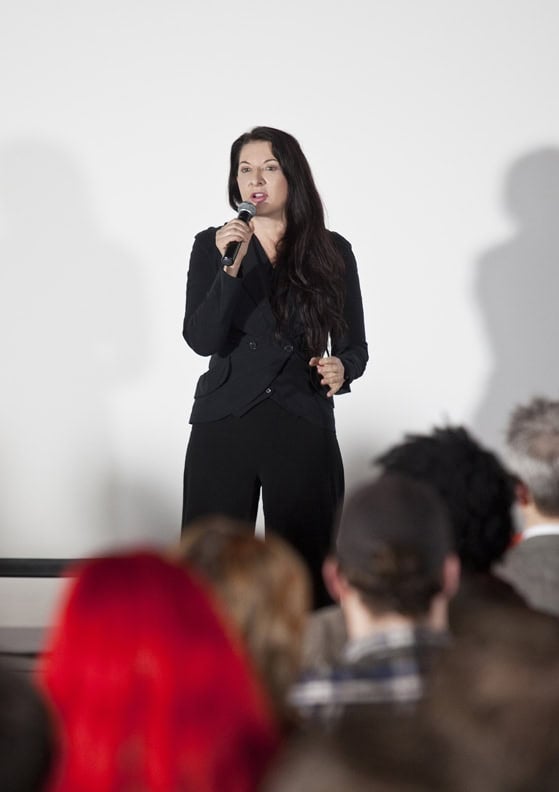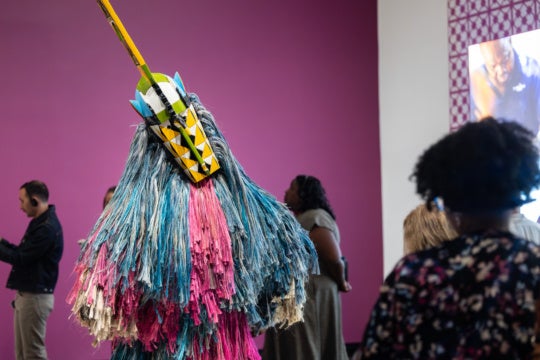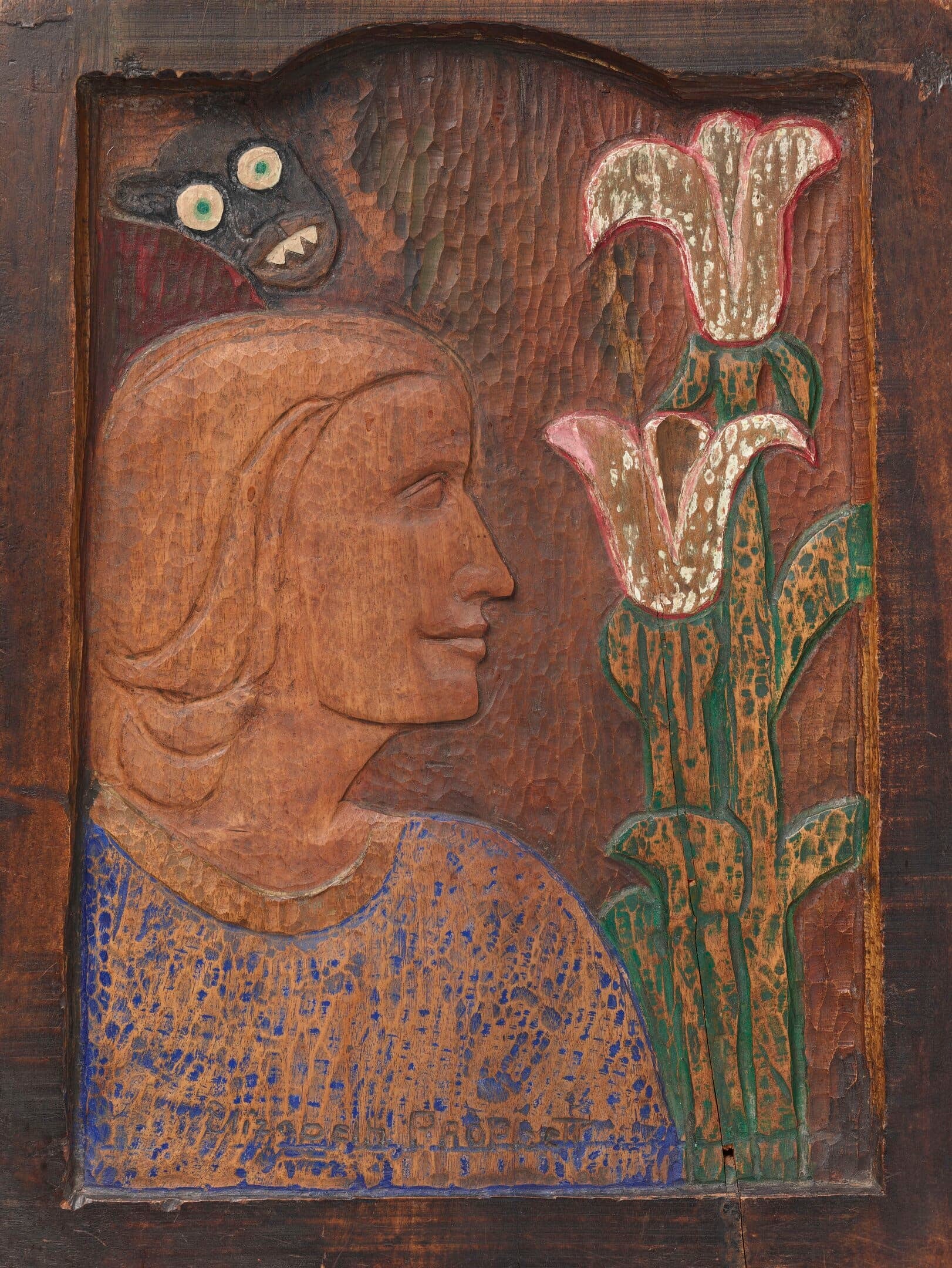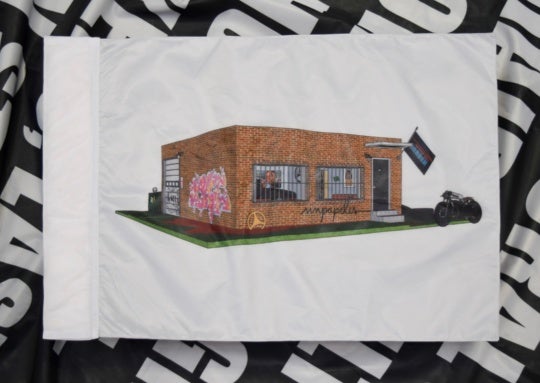
I met with Marina Abramović before her keynote address for SCAD-Atlanta’s second annual deFINE ART program. To be entirely truthful, I was nervous, something you can’t seem to avoid in the presence of the “grandmother of performance art.” My primary reception of Abramović has been in the form of still photographs that show her staring at people in The Artist Is Present, shouting into the face of her long-time partner and collaborator Ulay, or cutting pentagrams and five-pointed stars into her stomach. The thought of sitting down with her was somewhat daunting. I anticipated an intense interaction, and that’s what I got, an intensely warm and receptive interaction. Marina Abramović is very friendly and a pleasure to chat with, as I hope the transcript of our talk will show.
Given that Abramović has become such an icon in recent years, I knew the opportunity to talk with her would be a rare one, and so I opted to crowd-source questions from my friends who I knew would have questions for her. What follows is drawn from our recorded conversation while lounging on one of SCAD-Atlanta’s many lovely sofas.
Paul Boshears: It is a real pleasure and honor to sit here with you. Thank you ….
Marina Abramović: And I love your hat — it is green and matches your notebook which is very nice ….
PB: … Ha! Thanks so much. One does want a bit of color, I suppose…
MA: No, no. Definitely.
PB: Would you mind if I asked you a couple of questions?
MA: No, no. Yes. Definitely do.
PB: If you don’t mind I asked some friends — I crowd-sourced my questions for you. I told them that I was going to have this opportunity to chat with you, and mentioned I would be happy to ask you some questions on their behalf ….
MA: Oh, I love it. That’s a good idea. Let’s see what they asked me.
PB: Well, from BURNAWAY, the organization I am representing, they ask, “In another interview, you described an experience in which you were painting clouds one day and some military airplanes flew overhead. You mentioned that this was one of the moments that led you to abandon traditional two-dimensional work and begin performances using your body as the primary medium. What have you gained by choosing your current path? Have you ever thought about returning to two-dimensional work? Why or why not?”
MA: You know, I have been painting since I was a child, but I think I was a pretty lousy painter to begin with. So I would probably be a bad painter now if I had continued. It was at that moment when I realized the immateriality of that image, of that plane crossing and leaving those lines in the blue sky. At first you can see the line’s formation, then the drawing near, and then the disappearing into, again, that blue sky. That entire process and the immateriality of that process was a revelation — almost a spiritual revelation or an awakening in me. I understood how free we can be: to leave the studio, to live in any way possible, to imagine making art, and just use anything we want. Water, fire, 0ur bodies, ice — whatever we want. And when it came time to start doing it, when I first placed myself before the public, I knew that this was the right material for me.
I think that every artist has to find the best tool for them. And when you do find the best tool you have to go for it. So, for me to go back to painting would be uninteresting. I don’t know what I would do with a two-dimensional work. The only thing I thought of was that, maybe, as a kind of experiment, I would go to the desert and make some watercolors with my tears and sweat because those would be the only source of water available. But I didn’t do it.
PB: That is an evocative idea! And somewhat related to that image.
I have a question from Lauri Stallings; she has a dance company [gloATL] here in Atlanta. She asks, “Do [you] distinguish pleasure and pain to be two disparate worlds?” And her follow-up question is, “how do [you] feel about modernity doing away with performance, calling it the more wholesome experience?”
MA: You know, first of all this is very important: what you are doing and the context in which you are doing it. Let’s take bread as an example. If you make the best bread possible in a bakery, then you are a baker, but if you make this same bread in a gallery you are an artist. You see, the context changes everything.
We have in life one side that is pleasurable and one side that is painful. If I am choosing experiences for life, then I will choose pleasurable experiences, but for performances I choose painful experiences. I choose these painful experiences because they are things I don’t like to experience in life. You can never change in life if you never have painful experiences. So I choose to stage these difficult experiences, situations that are not easy to overcome, and go through these before the public. I use their energy, and that experience really changes me. In that way my work changes me, not my life.
Context is the most important thing: where you are doing it and when you are doing it. It’s not done in order to make you more experienced in life; it’s not like sitting with your psychoanalyst, or someone similar. This is art because it takes place in an artistic context.
PB: I like this, what you’re saying about an “artistic context.” This may seem like an extreme leap but … I study Classical Confucianism ….
MA: Like Confucius?
PB: Yeah.
MA: And not Daoism?
PB: Well, you can’t really have the one without the other, but …. I’ve been reading these somewhat radical translators who will point out that the received Confucius of today is misunderstood as this stodgy apologist, but in his original texts he focused a great deal on the ars contextualis, or the art of making one’s context. It emphasizes that your context makes you, and that one’s responsiveness to the context is crucial. In thinking about your recent performance of Seven Easy Pieces I’m reminded of this central value, ritual propriety (li 禮), in Confucianism. In that mode of thinking and living is the pursuit of performing rituals appropriately in accordance with one’s inheritance ….
MA: And understanding them and trying to move them further ….
PB: Right! And so you’re starting these artistic centers now, and speaking a lot about the need for appropriate citation of performance artists and their performances over the last 40 years of development ….
MA: You mean my center on the Hudson [the Marina Abramović Foundation for Preservation of Performance Art]. Yes. You know, you come to a certain point in your life when you begin to think about what you will leave behind. This year I will be 64, and I have to think about my legacy, the third act. Leonard Cohen was asked, “What are you planning next for your career?” He’s, what? Eighty now? He said, “What do you mean? I am in my third act, which always starts out good, but ends tragically with the actor dying.” So now I have to think about my legacy.
There are so many things to which I am saying “No,” at the moment, because I have to think about the younger artists. I have to put things together and try and make some sense out of all that has happened. As I come to understand my work, I see now that long-durational performances are the only ones that can really physically and mentally change the state of consciousness of the performer. Nothing else. In a shorter performance the performer can pretend; they can act. Look at my recent The Artist Is Present: It lasted for three months. It was life itself. It was more than anything I had ever done, and it really changed me. So I believe that I will gear the center toward long-performance art among many different artistic categories, including video, dance, and all those dinosaurs of the arts. At the moment, I am starting to work with opera. At a minimum all the performances will have to be six hours long. We are talking about something that has the potential to be really interesting to see: how the audience will change, and how the people doing it will change during such long, extensive performances.
I was recently offered a gift by the President of Montenegro, which was formerly a part of Yugoslavia, where I am from. He’s very young, only 36 years old. He is giving me a huge space of nearly 180,000 square meters, which is just enormous. It was originally a huge factory for nearly 8,000 workers during the presidency of Josip Broz Tito. I’ve been given a chance to use it to create my cultural center. So this is another enormous responsibility that I’ve taken on. We’re going to present the model of this center at the Venice Biennale this year. And then I also have the Hudson, which leaves me little time to do anything else. There’s truly nothing else I can do! I have two legacy projects! God!
Part of this work has me really interested in 3D images. I’m experimenting with scanning images of my body and seeing if I can project images of myself into thin air. I’m trying to project images without using a surface, like Star Wars. I am going to become ectoplasm! I’m interested in how far we can go with immateriality. Everything in our contemporary culture is about materiality, about goods you can touch, but there is this immaterial world that really matters.
PB: Somewhat related, my friend, Jamie Allen, asks, “What are the limits/affordances of an institutional performance art practice?”
MA: Yes, there are certainly many people who are against the institutionalization of performance art, but there are so many reasons to say “yes” to it as well. Look, photography and video weren’t shown for a long time as mainstream art forms but try and imagine the art world without them now. There is this incredible paranoia about what will happen if performance art is institutionalized, when it’s no longer in this no man’s land territory. Will it lose its spontaneity? I don’t think so. I’ve had enough of being alternative; for 40 years I’ve been alternative. I want to create a context in which performance can be mainstream. This is what I’m trying to pioneer. People are still coming to these performances and viewing them as entertainment. They come to the gallery, they drink their glasses of wine, and they chat, and nobody looks at the performance.
PB: Excellent. Do you have any questions for me?
MA: What are you doing?
PB: Well, I think I am going to get lunch after this ….
MA: No. What are you doing?
PB: I’m a researcher.
MA: What do you research? It can be many things.
PB: I’m in a low-residency graduate program based in Switzerland, and so I am writing my master’s thesis on the aesthetics of politics ….
MA: You see, the world can only change if the leaders of the world become, really become, spiritual. It’s a big subject, but maybe we can talk about it at tonight’s lecture.




